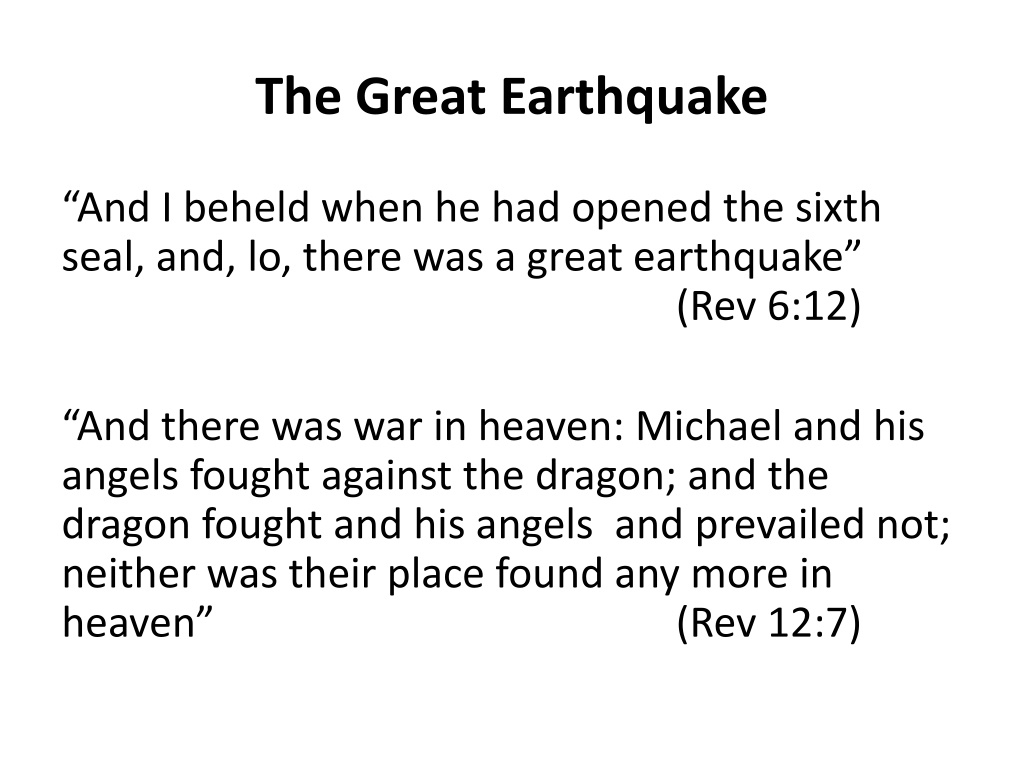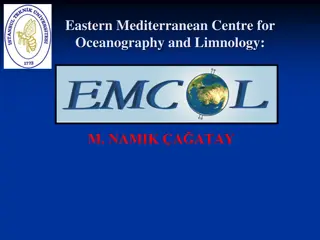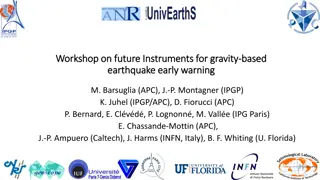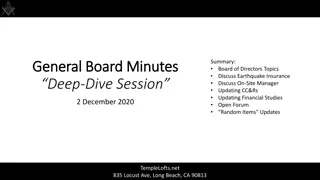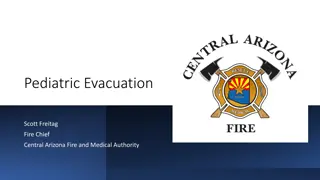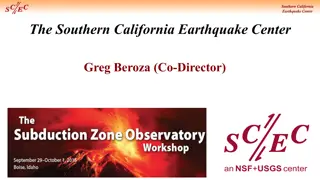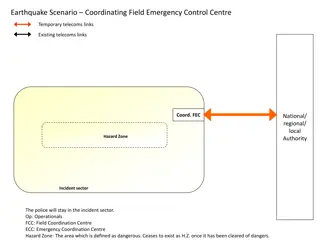The Great Earthquake
The content delves into biblical imagery, historical events involving Constantine, the Arian Controversy, the Nicene Creed, and the impact of the Christian Empire. It discusses the persecution of Christians, doctrinal debates, and the development of nominal Christianity within the context of Constantine's rule.
Download Presentation

Please find below an Image/Link to download the presentation.
The content on the website is provided AS IS for your information and personal use only. It may not be sold, licensed, or shared on other websites without obtaining consent from the author.If you encounter any issues during the download, it is possible that the publisher has removed the file from their server.
You are allowed to download the files provided on this website for personal or commercial use, subject to the condition that they are used lawfully. All files are the property of their respective owners.
The content on the website is provided AS IS for your information and personal use only. It may not be sold, licensed, or shared on other websites without obtaining consent from the author.
E N D
Presentation Transcript
The Great Earthquake And I beheld when he had opened the sixth seal, and, lo, there was a great earthquake (Rev 6:12) And there was war in heaven: Michael and his angels fought against the dragon; and the dragon fought and his angels and prevailed not; neither was their place found any more in heaven (Rev 12:7)
Constantine the Persecutor Tougher against Christian splinter-groups than against pagans, [Constantine] confiscated their churches and banished their bishops. The Donatists began to form a calendar of martyrs of their own Christianity, as soon as it became official, had begun to persecute Christians. In the east too, Constantine confiscated the churches of the various sects, and forbade them to hold services. (Michael Grant, The Climax of Rome, p.241)
Constantine and Church Doctrine The Arian Controversy Arius: Jesus is not God but was His firstborn Athanasius: Jesus was begotten, not created homousios : consubstantial; of the same substance a debate over the nature of Christ The Council of Nicea (325) the first of 7 Ecumenical councils ( infallible ) Constantine forces the Trinitarian result
The Nicene Creed The Apostle s Creed re: Christ And in Jesus Christ, his only Son, our Lord The Nicene Creed re: Christ And in one Lord Jesus Christ, the only-begotten Son of God, begotten of the Father; that is, of the essence of the Father, God of God, Light of Light, very God of very God, begotten, not made, being of one substance with the Father; by whom all things were made (P. Schaff, The Creeds of Christendom, v. I, p.27-9)
Nominal Christianity Vast masses of people everywhere now called themselves Christians and were formally incorporated in the Christian Church, who were as pagan as ever in heart. This made a great difference to Christianity. It has not yet, in the sixteen centuries since, recovered from the influx of worldly elements which began under Constantine. (Bevan, Christianity, p.116)
The Christian Empire Constantine supported and manipulated the Church for political reasons State funds provided, massive churches built Ecumenical Council was convened to decide on and define doctrines to be accepted as orthodox Heretics were persecuted People became Christians out of convenience
Part II The Late Fourth Century - pagans and heretics outlawed - orthodox Christianity is defined - growing power of Bishops The Fifth Century - emergence of the Papacy The Sixth Century - heretics outlawed - Bishop of Rome as statesman
Heretics Outlawed Theodosius (379-395) 153789 [Theodosius] considered every heretic as a rebel against the supreme powers of heaven and of earth In the space of fifteen years, he promulgated at least fifteen severe edicts against the heretics; more especially against those who rejected the doctrine of the Trinity (Gibbon, Decline & Fall, ed. Bury, v. 3, p.159)
Justinian (527-65) 192792 From the beginning of his reign Justinian promulgated the severest laws against heretics in 527 and 528. They were excluded from holding any public office, and from the liberal professions. Their meetings were forbidden and their churches shut. They were even deprived of some of their civil rights, for the Emperor declared that it was only right that orthodox persons should have more privileges in society than heretics (Cambridge Medieval History (1st ed.), v.2, p.43)
Orthodox Christianity is Defined Ecumenical Councils The first seven Ecumenical Councils are considered to be infallible by the Western and Eastern Churches Nicaea (325) Constantinople (381)* Ephesus (431) Chalcedon (451) Constantinople (553) Constantinople (680-1) Nicaea (787) Divinity of Christ Divinity of Holy Spirit Mary Mother of God Jesus had two natures Reaffirmation of Trinity Jesus had two wills Icons & relics legitimized * Trinity appears for the first time in Council text
Orthodox Christianity Theodosius (380) It is our desire that all the various nations which are subject to our Clemency and Moderation, should continue in the profession of that religion which was delivered to the Romans by the divine Apostle Peter, as it hath been preserved by faithful tradition; and which is now professed by the Pontiff Damasus [Bishop of Rome] and by Peter, Bishop of Alexandria, a man of apostolic holiness.
Orthodox Christianity (contd) According to the apostolic teaching and the doctrine of the Gospel, let us believe the one deity of the Father, the Son and the Holy Spirit, in equal majesty and in a holy Trinity. We authorize the followers of this law to assume the title of Catholic Christians; but as for the others, since, in our judgement, they are foolish madmen, we decree that they shall be branded with the ignominious name of heretics, and shall not presume to give to their conventicles the name of churches. They will suffer the punishment which our authority, in accordance with the will of Heaven, shall decide to inflict. (Bettenson, Documents of the Chr. Church)
Growing Power of Bishops Theodosius & the Bishop of Milan With his own hand, [Ambrose] wrote a private letter to the Emperor, acknowledging his zeal and love for God, but claiming that for such a crime of headlong passion there must be profound contrition until repentance he dare not offer the sacrifice in the Emperor s presence With his subjects around him in the Cathedral of Milan the Emperor, stripped of his royal purple, bowed himself in humility before the offended majesty of Heaven. (Cambridge Medieval History (1st ed.), v.1, p.244-5)
Growing Power of Bishops Bishops Bishops became leaders Controlled Church property Met in synods with other bishops to decide authoritatively on doctrinal matters Bishops of a provincial capital city had authority over bishops of other cities - known as Metropolitan Bishops of five major cities became particularly important - known as Patriarch Often described as Latin papa or Greek pappas
Patriarchates East 1) Constantinople 2) Alexandria 3) Antioch 4) Jerusalem West 1) Rome
The Primacy of Rome Council of Constantinople (381) The Bishop of Constantinople to have the primacy of honour next after the Bishop of Rome, because that Constantinople is New Rome. (Bettenson, Documents of the Chr. Church, p.116)
The Emergence of the Papacy 153179 Valentinian III (445) We are convinced that the only defence for us and for our Empire is in the favour of the God of heaven: and in order to deserve this favour it is our first care to support the Christian faith and its venerable religion.
The Emergence of the Papacy (contd) Therefore, inasmuch as the pre-eminence of the Apostolic See is assured by the merit of St. Peter, the first of the bishops, by the leading position of the city of Rome and also by the authority of the holy synod, let not presumption strive to attempt anything contrary to the authority of that See. For the peace of the churches will only then be everywhere preserved when the whole body acknowledge its ruler nothing shall be attempted... without the authority of the venerable pope of the Eternal City. But whatsoever the authority of the Apostolic See has enacted, or shall enact, let that be held as law for all. (Bettenson, Documents of the Chr. Church)
Eastern Control of West Declines Constantine moved the capital of the empire from Rome to Constantinople in 324. Emperor of the East held temporal and spiritual authority, and appointed the Roman Bishop. From the latter part of the fifth century the titular Roman Emperor with his seat at Constantinople had only precarious and intermittent control over the Latin- speaking lands Italy and the West (Bevan, Christianity, p. 117)
Pope Gregory (590-604) Since 476 there had been no emperor residing in the west, and the way was open for the extension of papal power in Italy. There a new race of barbarians had appeared, and it fell to the papacy to struggle with these new invaders (Deanesly, A History of the Medieval Church, p.15)
Pope Gregory (contd) The maintenance of the imperial power in Italy indeed depended not a little on the great Pope [Gregory], who yet by his incessant and widespread activity was preparing the way of the ecclesiastical power which should succeed it in the rule of the peninsula Gregory the Great is said to have originated the medieval Papacy Cambridge Medieval History (1st ed.), v.2, p.248, 685
The Emperor Endorses the Papacy Phocas (602-610) for when the bishops of Constantinople maintained that their church was not only equal in dignity and authority to that of Rome, but also the head of all the Christian churches, this tyrant [Phocas] opposed their pretensions, and granted the pre-eminence to the church of Rome; and thus was the papal supremacy first introduced. (Mosheim, Ecclesiastical History, v. I, p. 160)
The Emperor Endorses the Papacy Phocas (602-610) [Phocas ] markedly conciliatory policy towards Rome culminated in an edict addressed to Pope Boniface III in which he recognized the Apostolic Church of St. Peter as the head of all the churches. A column erected in the Roman forum with an inscription praising the Byzantine tyrant showed the remarkable favour which Phocas enjoyed in Rome. (Ostrogorsky, History of the Byzantine State, p.76-7)
The Dragon & Beast of the Sea Rev 13:1 And I stood upon the sand of the sea, and saw a beast rise up out of the sea, having seven heads and ten horns, and upon his horns ten crowns, and upon his heads the name of blasphemy. 2 And the beast which I saw was like unto a leopard, and his feet were as the feet of a bear, and his mouth as the mouth of a lion: and the dragon gave him his power, and his seat, and great authority. 3 And I saw one of his heads as it were wounded to death; and his deadly wound was healed: and all the world wondered after the beast. 4 And they worshipped the dragon which gave power unto the beast: and they worshipped the beast, saying, Who is like unto the beast? who is able to make war with him? 5 And there was given unto him a mouth speaking great things and blasphemies; and power was given unto him to continue forty and two months. 6 And he opened his mouth in blasphemy against God, to blaspheme his name, and his tabernacle, and them that dwell in heaven. 7 And it was given unto him to make war with the saints, and to overcome them: and power was given him over all kindreds, and tongues, and nations. 8 And all that dwell upon the earth shall worship him, whose names are not written in the book of life of the Lamb slain from the foundation of the world.
The Phases of the Beast Daniel s 4th Beast Red Dragon Beast of the Sea Dan 7 Rev 12 Rev 13 One Head Seven Heads Seven Heads Ten Horns Ten Horns Ten Horns Crowns on Heads Crowns on Horns Mouth Speaks against God Mouth Speaks Blasphemy Wars with the Saints Wars with the Remnant Wars with the Saints
The Phases of the Beast Daniel s Four Beasts Beast of the Sea Dan 7 Rev 13 Lion = Babylon Mouth of Lion Bear = Medo-Persia Feet of Bear Leopard = Greece Form of a Leopard Dreadful Beast = Rome Beast of the Sea Little Horn with Mouth Speaking Great Things Mouth Speaks Blasphemy Wars with the Saints Wars with the Saints
The Dragon & Beast of the Sea Symbol Interpretation Beast of Sea Revived Western Imperial Power in Rome The Dragon Eastern Roman Imperial Power in Constantinople Wounded Head Western Imperial System Overthrown by Barbarians Healed Head Western Imperial System Restored by Eastern Emperor Mouth Speaking Blasphemies Roman Bishop s Power and Authority Wars with the Saints Persecution of True Believers
